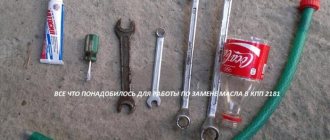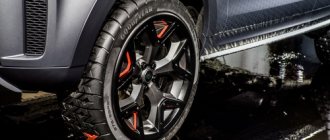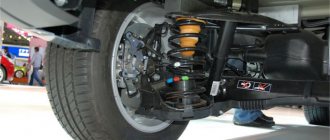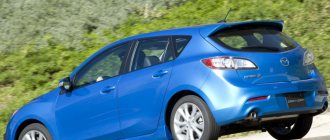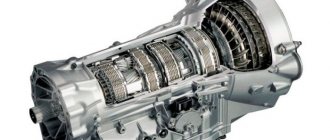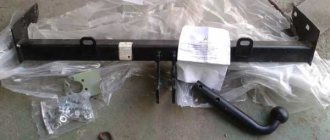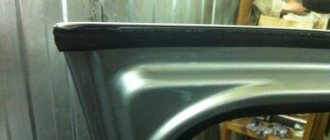Rivals:
- Lifan X50 - petrol, 1.5 l (103 hp), 5-speed manual, Comfort, RUB 499,900.
- Lada Kalina Cross - petrol, 1.6 l (106 hp), 5-speed robot, Norma, RUB 523,100.
- Lada XRAY - petrol, 1.6 l (114 hp), 5-speed manual, from RUB 589,000.
- Renault Sandero Stepway - petrol, 1.6 l (82 hp), 5-speed manual, Confort, RUB 637,470.
Since 1891, in accordance with the Treaty of Madrid, sparkling wines produced exclusively in the province of the same name in France can be called champagne.
Is it a coincidence that this decision was made almost simultaneously with the appearance of the best brand of champagne in the Russian Empire? After all, sparkling wines produced near Lake Abrau were rightfully considered not inferior to French ones, or even superior to them. History repeats itself! Russian manufacturers again started from the French formula and implemented it in their own way. The recipe is simple: take a regular hatchback, add ground clearance, and decorate it with an all-terrain body kit. A bright color and a new name will also come in handy, preferably with the letter X. Done! Meet the front-wheel drive crossover Lada XRAY, derived from the Renault Sandero Stepway. A couple of weeks before the start of Xray production, we tested a pre-production car with a 16-valve Nissan HR16-H4M engine (114 hp) and a manual gearbox. Of course, the already mentioned Stepway was identified as a competitor - however, with an eight-valve engine, but it has the same gearbox. It is noteworthy that these machines are produced on one line of the Tolyatti conveyor. Another native of the Volga region is the Lada Kalina in the Cross all-terrain version, with a 16-valve engine and a robotic gearbox. Well, the Russian bottling will be diluted by the next X-hatchback from China - Lifan X50 (1.5 l, 103 hp).
Fifty Shades of Gray
45-lifan_zr-02_16
Lifan X50.
The gray interior of the Lifan is made of hard plastic. There are questions regarding ergonomics. The heater control unit takes some getting used to: there are coaxial temperature and fan speed controls. And the build quality is not the best. There are no questions about the gear shift mechanism, and the gear ratios are chosen well. Lifan X50. The gray interior of the Lifan is made of hard plastic. There are questions regarding ergonomics. The heater control unit takes some getting used to: there are coaxial temperature and fan speed controls. And the build quality is not the best. There are no questions about the gear shift mechanism, and the gear ratios are chosen well.
Lifan X50
- The pseudo-off-road hatchback Lifan X50 has been on sale since the summer of 2020. Built on a common platform with the Lifan Celliya sedan. There is no all-wheel drive version.
- Engine: petrol 1.5 l (103 hp) - from 499,900 rubles. (excluding options).
Externally, the Lifan X50 is quite good, although there is a bit of plagiarism: you can feel the motifs of the Opel Mokka crossover in it. It's a pity, the dark gray color neutralizes the nuances of the body lines. The interior is also fifty shades of gray. Only the scarlet instrument cluster catches the eye. A beautiful wrapper does not guarantee a tasty filling. Ergonomics will appeal only to fans of the aforementioned sensational novel who prefer an original pastime. The leatherette-covered driver's seat is set high and does not have a microlift. The side support rollers are too close together and rest unpleasantly on the lower back: after half an hour, the back begs for mercy. For drivers over 170 cm tall, part of the view is blocked by the ceiling falling towards the windshield. The steering wheel has a good cross-section, but is trimmed with too slippery plastic, and the audio system control buttons are located almost on the rim—I accidentally pressed them a couple of times. Against this background, you forgive other strange decisions. For example, blind seat heating buttons at the end of the cushion or handwheels for adjusting temperature and airflow intensity sitting on a common axis.
Specifications
Engines
In terms of the number of engines, competitors have parity - 3 units each. But in terms of technical data, the leadership should be given to Renault, because its engines are not only more advanced, but their list also includes a diesel option, which X-Ray lacks.
The base engine of the domestic model is an in-line, 4-cylinder power unit VAZ-21129 (16-valve), developed by Russian engineers. It has a transverse arrangement, and the power system is represented by fuel injection with electronic control. This design guarantees a peak power of 106 hp. With. (78.2 kW) at 5,800 rpm. And already at 4,200 rpm the maximum torque is reached, which is equal to 148 Nm.
VAZ-21129 is the base engine of the Lada X-Ray.
Such characteristics guarantee the Lada X-Ray with this engine acceleration to hundreds in 11.4 seconds, with maximum speed of 174 km/h. The consumption that you will have to pay for the dynamics is quite acceptable - 9.3/7.2/5.9 liters for the city, mixed mode and highway, respectively.
The starting power unit of the Renault Duster is a 114-horsepower (84 kW), 1.6-liter engine of the HR16DE series with a timing chain drive, also two pairs of cylinders and 16 valves. Renault's fuel injection is distributed, electronically controlled. With it, the French SUV develops peak power at 5,500 rpm, complementing this with a torque of 156 Nm at 4,000 rpm. The dynamics are quite decent - 10.9 seconds. (2x4) or 12.5 sec. (4x4), and the maximum speed is 166 km/h. Appetite – 9.3/7.4/6.3 l.
The Duster is initially equipped with an HR16DE engine.
The same engine is the second engine of the Lada X-Ray. However, there is nothing surprising in the fact that the Alliance shared its developments with AvtoVAZ. But this motor was adapted to Russian conditions. In particular, its power was reduced to 110 hp. With. (81 kW), and thrust decreased to 150 Nm. However, the speed of achieving these indicators remained the same - 5,500 and 4,000 revolutions. The dynamics are approximately equal to those of Renault - 11.1 seconds. But the maximum speed is noticeably higher and is 181 km/h. And the consumption of the Lada XRAY is less - 8.9/6.8/5.6 liters.
The same engine, but adapted for Russia, is also found on the Lada X-Ray.
The most powerful X-Ray engine turned out to be a 122-horsepower, 1.8-liter engine. This is a new development of domestic engineers. However, in the main points it repeats the previous engines - in-line layout, transverse arrangement of 4 and 16 valves and cylinders, respectively, injection power system, etc. With it, the Lada is noticeably more dynamic and exchanges 100 km in 10.9 seconds, accelerating to 186 km/ h, while consuming 8.6/6.8/5.8 l AI-95.
The new 1.8-liter Lada engine is the pinnacle of AvtoVAZ engineering.
But it’s not easy to give Renault the palm, since the remaining two engines are aimed at fundamentally different buyers. This is a 2-liter petrol unit and a 1.5-liter turbocharged diesel engine.
The petrol engine has 16 valves and develops 143 hp. With. (105 kW) power, supplemented by a torque of 193 Nm, thanks to which it is able to accelerate the SUV to hundreds in just 10.3 seconds, reaching a maximum of 180 km/h. You have to pay for this with a consumption of 10.1/7.8/6.5 liters.
The 2-liter gasoline power unit gives the Duster dynamics at a decent level.
But the diesel is aimed at a calmer audience. Of course, its acceleration is 13.2 seconds. It can’t be called a sprint car, and the top speed of 167 km/h is frankly not impressive, as is the output of 109 hp. With. (at 4,000 rpm), although for such a volume and 8-valve layout this is an excellent result. However, the thrust of 240 Nm, which is already available at 1,750 rpm, more than compensates for everything, coupled with diesel consumption at the level of 5.9/5.3/5.0 liters.
The presence of a turbodiesel is a strong trump card in the Russian market.
As you can see, this round remains with Renault Duster. Despite the equal number of engines and the commonality of one of them, the Frenchman’s 2-liter unit is superior to the 1.8-liter Lada XRAY engine, while there is no diesel option under the hood of the domestic hatchback.
Gearboxes
The situation here is twofold. In terms of manual transmissions, the leadership can be given to Renault Duster. After all, it offers both 5- and 6-speed transmissions, while AvtoVAZ, although it equips its cars with a pair of French-made mechanical units, both of them are 5-speed.
French manual transmissions are great for X-Ray.
However, Renault’s advantage is minimal and it primarily affects the aspect of efficiency, which can be increased by the presence of 6th speed.
The 6-speed Renault Duster makes the SUV more economical.
When it comes to automatic transmissions, both companies have chosen their own path. AvtoVAZ settled on a 5-band AMT, created on the basis of a manual gearbox type 21826. Renault chose a 4-band automatic transmission of a classic design. If you compare both units, it becomes clear that driving in the city is more comfortable in the Duster, whose transmission jerks less in traffic jams and changes gears more smoothly.
The Renault Duster automatic is not bad, but only 4-speed.
But on the track, X-Ray completely wins back, because listening to the raised tones of the engine of a French crossover, which clearly lacks 5th speed, is not the most pleasant experience. And in general, asking almost a million rubles for a car, Renault could fork out for a more modern, 5-band transmission.
AMT Lada XRAY outperforms the Frenchman's automatic transmission in terms of the number of gears.
Chassis
In this regard, the advantage of Renault Duster is obvious. However, this is achieved due to the presence of all-wheel drive versions, which X Rey lacks. Nissan Murano shared an electromagnetic clutch of the GKN type with Renault. At the same time, Lock mode operates at speeds of up to 80 km/h, which virtually eliminates the possibility of overheating. In addition, if on front-wheel drive versions the rear suspension is represented by a torsion beam, then all-wheel drive modifications already have a completely independent, multi-link design.
The multi-link chassis is not available in all versions of Renault.
Lada is not able to offer such variety. All its modifications are equipped exclusively with a torsion beam. In general, if we compare the X-Ray with the front-wheel drive versions of the Duster, then in terms of handling it will not be inferior to the Frenchman, and in some aspects, thanks to lower ground clearance and, as a result, less windage, it will surpass it. But the domestic hatchback does not reach the level of taxiing of all-wheel drive Renaults.
X Ray has no alternative to the torsion beam.
27-kalina_zr-02_16
Lada Kalina Cross.
Kalina's simple front panel is functional. In the Lux version, the place of the box in the upper part is occupied by an add-on with a display. Orange elements enliven the realm of black plastic. Simple climate control is effective, including in automatic mode. The AMT robot is slow when switching and eats up the dynamics. You can realize all the capabilities of the 106-horsepower engine only in manual shift mode. Lada Kalina Cross. Kalina's simple front panel is functional. In the Lux version, the place of the box in the upper part is occupied by an add-on with a display. Orange elements enliven the realm of black plastic. Simple climate control is effective, including in automatic mode. The AMT robot is slow when switching and eats up the dynamics. You can realize all the capabilities of the 106-horsepower engine only in manual shift mode.
Lada Kalina Cross
- The pseudo-off-road version of the Lada Kalina station wagon debuted a year after the launch of the updated model. It features a plastic body kit and increased ground clearance. There is no all-wheel drive version.
- Gasoline engines: 1.6 l, 8V (87 hp) - from 486,600 rubles, 1.6 l, 16V (106 hp) - from 500,500 rubles. (excluding options).
After the “Chinese”, Kalina gives the impression of a finished product. And it looks bright - thanks to the orange color and the “cross” plastic body kit. The interior has also been refreshed with orange touches. The seat is softly padded and has a short cushion, but it distributes the load like a human being and allows you to ride for a long time without getting tired. Seat height adjustment is not provided here either, but it is not particularly necessary. You won't accidentally hit the buttons on the steering wheel - they aren't there. The rim of the steering wheel is a bit thin, but it fits comfortably in your hands, and that’s the main thing. What a review! Huge windows, impressive mirrors and a high seating position allow you to effortlessly control the situation around the car and not fork out for parking sensors.
Kalina Cross or x Ray
Both options from one. The domestic giant has long been introducing competitors in its products that make buyers think about the next car upgrade.
Now they often compare: Kalina Cross or x Rey. There are differences between them, but in general the models are similar to each other.
| Automobile | Kalina Cross | Lada Xray |
| Average price of a new car | ~ 562,700 q | ~ 589 900 |
| Fuel type | Gasoline AI-95 | Gasoline AI-92 |
| Body type | Station wagon | Hatchback |
| Transmission type | Manual transmission 5 | Manual transmission 5 |
| type of drive | Front (FF) | Front (FF) |
| — | — | |
| Engine capacity, cc | 1596 | 1596 |
| Power | 106 hp | 106 hp |
| Maximum torque, N*m (kg*m) at rpm. | 148 (15) / 4200 | 148 (15) / 4200 |
| Fuel tank volume, l | 50 | 50 |
| Number of doors | 5 | 5 |
| Trunk volume, l | 355 | 361 |
| Acceleration time 0-100 km/h, s | 10.8 | 11.4 |
| Weight, kg | 1160 | 1190 |
| Body length | 4104 | 4165 |
| Body height | 1560 | 1570 |
| Wheelbase, mm | 2476 | 2592 |
| Ground clearance (ride height), mm | 183 | 195 |
| Fuel consumption, l/100 km | 7 | 7.2 |
| Rear wheels | 195/55 R15 | 195/65 R15 |
So far, for x Ray Cross there is no choice among engines: 1.8 l (122 hp) 5MT. Although at the same time it remains quite powerful, which meets the requirements of the increased cross-country ability of our elevated crossover.
At the same time, Kalina Cross will be able to offer two 1.6 liter power units: 87 hp. p., 106 l. s., as well as a choice of 5MT and 5Robot. The ability to more flexibly adjust the car to the driver with a small budget.
Dramatic differences:
- The Lada Xray Cross is larger in all body parameters, ground clearance is 215 mm versus 183 mm, the trunk is larger by 6 liters - 361 liters;
- Lada Kalina Cross is more economical due to the engine features, has a robotic transmission, and is lighter in weight.
Similar options:
- front-wheel drive;
- 5 gears each;
- gasoline engines;
- fuel tank volume.
Also, don’t forget that x Ray Cross is at R17, and Kalina Cross is at R15. It basically all depends on the availability of money in your pocket. For Xray Cross they ask from 729 thousand rubles. Kalina will cost an order of magnitude lower due to the 87 hp engine. pp.: from 545 thousand rubles.
Options and prices of Lada Xray 2019
| Equipment | Price (rubles) |
| 1.6 l 16 cl. (106 hp), 5MT OPTIMA | from 599 900 |
| 1.6 l 16-cl. (106 hp), 5MT OPTIMA Advanced | from 660 900 |
| 1.8 l 16 cl. (122 hp), 5MT OPTIMA Advanced | from 685 900 |
| 1.8 l 16 cl. (122 hp), 5AMT OPTIMA Advanced | from 710 900 |
| 1.6 l 16-cl. (106 hp), 5MT LUXE | from 710 900 |
| 1.6 l 16-cl. (106 hp), 5MT Prestige LUXE | from 739 900 |
| 1.8 l 16 cl. (122 hp), 5MT LUXE | from 735 900 |
| 1.8 l 16 cl. (122 hp), 5MT Prestige LUXE | from 773 900 |
| 1.8 l 16 cl. (122 hp), 5AMT LUXE | from 760 900 |
| 1.8 l 16 cl. (122 hp), 5AMT Prestige LUXE | from 798 900 |
| 1.8 l 16 cl. (122 hp), 5MT EXCLUSIVE | from 805 900 |
| 1.8 l 16 cl. (122 hp), 5AMT EXCLUSIVE | from 830 900 |
The undoubted advantage of the Lada Xray is the presence of some options that, in principle, the Sandero Stepway does not have. With almost the same cost of 752 thousand rubles for the Lada X-Ray and 757,000 rubles for the Sandero Stepway, the Lada Trump has light and rain sensors, a rear view camera, and even has a triple blinking turn signal function. The brainchild of AvtoVAZ does not have side airbags and does not have cruise control, which is actually a plus for the Sandero Stepway, it also has a stabilization system.
Is there a loss in power?
But the most important difference between cars with the same cost and more or less similar configurations is the engine. The Lada Hray is equipped with an engine with a displacement of 1.8 liters and a power of 122 horses, with a torque of 170 Newton meters. But the Sandero Stepway got a weak engine with a displacement of 1.6 liters, a power of only 82, but frisky horses, since the torque is 134 Newton meters. And the manufacturer’s data says that Lada should cover the first hundred in 10.9 seconds, and Renault in 12.6. Seeing these numbers, you immediately get the feeling that the Lada X-Ray should start from a standstill and leave the Renault Sandero Stepway far behind. But not everything is so smooth, even without comparison with Renault.
Sandero Stepway feels very good and cheerful in the city, showed good traction at the bottom, and the gear ratios are supported very precisely, which gives it the opportunity to not lag too far behind X-Ray, but this is in the city. Outside the city, Renault has no life after a hundred, the engine does not pull. But the Lada Xray, on the contrary, feels very good when overtaking, and goes uphill well.
But don’t rush to rejoice, both transmissions are lousy. Although their names are different (AMT for Lada and Easy'R for Renault), the behavior is the same. They are robotic five-speed gearboxes with one clutch controlled by a ZF mechanism. The rhythm of driving in big cities with its traffic jams, tight parking lots and all the delights of a huge flow of cars is not at all for these boxes. There is no talk of any smoothness of movement or clarity of switching. Boxes often become dull, especially in heavy traffic. Also in the Lada, one gets the impression that a powerful engine will simply tear the transmission, since the vibrations are quite noticeable.
Video test drive
I would also like to say something about fuel consumption, no matter how paradoxical it may sound, but the Lada Xray consumes less fuel than the Renault Sandero Stepway. On average, a Lada Hray with a 1.8-liter engine spends 8/8.2 liters per 100 km, with 92 gasoline, but the Sandero Stepway with a 1.6 engine spends 8.5/8.6 liters per hundred. Also, the Sandero has a key-locked gas tank flap, but the Lada does not.
Who is in what element?
Driving-wise, both cars are very similar. Although AvtoVAZ claims that they have completely redesigned the chassis compared to its ancestor, the Sandero. They noted that they managed to widen the rear track, as well as make the ride smoother, and redesigned the suspension. The Lada Xray behaves more adequately on an asphalt road, holds its course well, and you don’t have to put too much effort on the steering wheel; the car has an electro-hydraulic power steering. But the French little car performs very well on dirt roads and, in principle, on bumpy surfaces. On a bad road, bumps are absorbed on the Sandero Stepway better than on the Lada X-Ray. But the Sandero will have to put more effort into the steering wheel.
AvtoVAZ engineers were able to not only take the design of the Renault Sandero Stepway and restyle it, they found a completely different approach and radically redesigned the car, making something of their own, recognizable on the road and unlike its competitors. In general, the Lada Xray is very well equipped, it has a more powerful engine, it looks very fresh and is very suitable for the city. Renault Sandero Stepway, in turn, offers a higher brand image, better service, and they also offer a version with a 102 horsepower engine and a full-fledged 4-speed automatic that doesn’t act like a robot. And this situation makes Sandero Stepway a very attractive option, moreover, it is also very well equipped. In any case, everyone chooses what they like best.
Comparing Lada Vesta and Lada Largus, at first glance, will seem incorrect, due to the fact that both models occupy different niches in the market. However, they overlap in many ways. After all, many of those who were planning to purchase a Grant, Largus or Priora, after the new sedan entered the market, thought about changing their guidelines, sometimes to the detriment of their own needs. The same applies to potential owners of LADA Largus. Moreover, this decision is largely dictated by the parameters of the cars.
Technical component
Let's move on to the technical specifications and start with the power plants. It is worth noting here that both manufacturers use their own power plants, that is, the models do not have the same versions of engines, despite AvtoVAZ’s close cooperation with Renault.
So, now X-Ray is equipped with two versions of power units. The first of them has a volume of 1.6 liters and produces 106 liters. With. The second motor is more powerful. It has a volume of 1.8 liters, which allows it to produce 122 liters. With. The first versions of the Lada were also equipped with a unit from Nissan, but now it is no longer in the lineup.
Renault Sandero is equipped with three engine variations, but all of them are 1.6-liter. At the same time, their power is different, the first produces 82 hp. s., second – 102 l. s., and the top one develops 113 hp. With.
As you can see, the X-Ray engines are better in terms of power performance, and only the 113-horsepower version can still “compete” with the base 1.6-liter Lada unit.
Now - transmissions. For the X-Ray with a 1.6-liter unit, only a 5-speed manual transmission is offered, and for the version with a 1.8-liter engine, the same manual transmission and a 5-speed robotic gearbox are provided. It is worth noting that the manual transmission installed on the Lada is a Renault development.
Sandero has a wider choice of transmissions. The version with an 82-horsepower engine is equipped with a 5-speed manual transmission and a 5-speed manual transmission. For Renault with a 102 hp engine. With. Only one gearbox is provided - automatic, 4-speed. And the model with the top-end unit is only paired with a manual gearbox.
Both models are exclusively front-wheel drive.
As for speed indicators and fuel consumption, in the basic version with a stock engine, Renault develops a maximum of 172 km/h, and reaches a hundred in 11.9 seconds. For the basic X-Ray, these figures are slightly better - 176 km/h maximum speed and 11.2 seconds - time to reach 100 km/h. The same parameters are better in the top versions of these cars, but not by much.
Fuel consumption in mixed mode is the same for both cars - 7.2 l/100 km. In the urban cycle, X-Ray is more economical - 9.3 liters versus 9.8 liters. But outside the city, the Sandero consumes 0.1 liters less than the Lada (5.9 liters/100 km).
Options and prices of Sandero Stepway 2020
| Equipment | Price (rubles) |
| 1.6 l 8-cl. (82 hp), 5MT Confort | from 639 990 |
| 1.6 l 16-cl. (102 hp), 4 automatic transmission Confort | from 709 990 |
| 1.8 l 16 cl. (113 hp), 5MT Confort | from 679 990 |
| 1.6 l 8-cl. (82 hp), 5MT Privilege | from 715 990 |
| 1.6 l 16-cl. (102 hp), 4 automatic transmission Privilege | from 785 990 |
| 1.8 l 16 cl. (113 hp), 5MT Privilege | from 755 990 |

